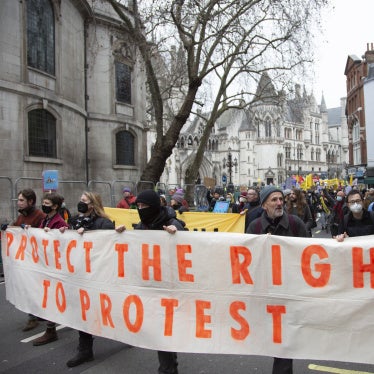Mr. Edwin J. Feulner
President, Executive Offices
Heritage Foundation
214 Massachusetts Ave NE
Washington DC 20002-4999
Fax: 202.546.8328
Dear Mr. Feulner:
We are writing to alert you to several errors contained in the recently-published report by the Heritage Foundation: Adult Time for Adult Crimes: Life without Parole for Juvenile Killers and Violent Teens (hereinafter "Heritage report"). These errors appear in multiple sections providing commentary on a report published by Human Rights Watch and Amnesty International in 2005: The Rest of Their Lives: Life without Parole for Child Offenders in the United States (hereinafter "HRW/AI report"). Both the Heritage and HRW/AI reports analyze the United States criminal justice policy of sentencing persons below the age of 18 at the time of offense to life in prison without the possibility of parole (LWOP). We do not attempt to comment on all errors contained in the Heritage report, but instead focus on five key points that relate specifically to our research and reporting.
First, the Heritage report contains several accusations directed at Human Rights Watch and other groups, maligning our research methods (Heritage report, p. 7, (describing our report and those of others as a "carefully crafted campaign of misinformation")). Nevertheless, we were surprised to find that you simultaneously chose to rely on Human Rights Watch's research when it furthered your arguments. For example, you cite the HRW/AI report as authoritative research on page 37 (your citation to our research on the mandatory nature of the life without parole sentence), as well as on page 70 (your citation to our finding that 93 percent of under-18 offenders serving life without parole were homicide offenders).
Second, on page 10 you allege that the HRW/AI report includes photographs of youth serving LWOP "taken years before the crime was committed." This patently misleading claim fails to account for the fact that next to each of the 27 photos in the HRW/AI report we provided the age of each young person depicted, as well as the age the individual was at the time of his or her offense. In all but two cases, we did not use a photograph unless it depicted the individual no more than one year prior to his or her crime. Therefore, in our report, the youngest individuals depicted were three persons shown at age 13, all of whom committed their crimes at age 14. In two cases out of the 27 an individual was depicted at age 14 who committed his crime at age 16, and another individual was depicted at age 15 who committed his crime at age 17. All of this information was clearly available to the Heritage report's authors.
Third, we were interested to find nothing in Appendix 1 to the Heritage report that contradicted or proved erroneous anything contained in the two case studies you chose to feature from the HRW/AI report, despite your claim that the Appendix would "correct the mistaken impressions" provided by these case studies.
Fourth, we note that there is a significant disagreement between your organization and our own regarding the international laws that prohibit sentencing youth offenders to life without parole. We stand by our legal research and analysis clarifying the international human rights standards that are violated by the United States' practice of sentencing youth to life without parole, which we have published in numerous contexts, including in the 2005 HRW/AI report. (See, e.g., Human Rights Watch and Amnesty International, The Rest of Their Lives: Life Without Parole for Child Offenders in the United States, Just Sentences for Youth: International Human Rights Law, October 11, 2005; Human Rights Watch Submission to CERD, Racial Disparities in the Sentencing of Youth to Life without Parole, February 6, 2008; Human Rights Watch Submission to the Human Rights Committee, July 11, 2006,).
Our conclusion that sentencing youth offenders to LWOP violates treaty obligations of the United States is shared by two authoritative bodies charged with overseeing the United States' and other governments' compliance with their treaty obligations. (See Concluding Observations of the Human Rights Committee, December 18, 2006 (stating that "The State party should ensure that no such child offender is sentenced to life imprisonment without parole, and should adopt all appropriate measures to review the situation of persons already serving such sentences"); Concluding Observations of the Committee on the Elimination of Racial Discrimination, May 8, 2008 ("In light of the disproportionate imposition of life imprisonment without parole on young offenders, including children, belonging to racial, ethnic and national minorities, the Committee considers that the persistence of such sentencing is incompatible with article 5 (a) of the Convention. The Committee therefore recommends that the State party discontinue the use of life sentence without parole against persons under the age of eighteen at the time the offence was committed, and review the situation of persons already serving such sentences.").)
Finally, there are numerous misleading assertions and errors in your report related to our conclusion that, in 2005, there were "at least 2,225" persons who were below the age of 18 at the time of offense serving life without parole sentences in the United States. The following paragraphs are devoted to responding to these assertions and errors.
On page 4 of the Heritage report you assert that this figure Human Rights Watch published in 2005 "is nothing more than a manufactured statistic." We categorically reject this assertion. The statistic we reported was based on data gathered directly from state departments of corrections. If there are errors in the data reported, this will be due to the states themselves. We have always publicly described the significant challenges we faced in gathering these numbers-challenges we accurately reported on and sourced in our report. Indeed, we find it puzzling that the Heritage report, while alleging that our statistical work was "manufactured," offers verbatim quotes of our detailed and accurate reporting on how we arrived at this number (Heritage report, pp. 13-15 (quoting HRW's detailed description of our methodology)).
On page 15 you analyze our original requests to states to provide both life without parole and life plus years sentencing data. With regard to the "life plus years sentences," you go on to make the misleading allegation that "some [of those sentences] may still remain [in the data] from states that conflated the requests." (Heritage report, p. 15). Your report even provides a citation to page 119 of our report, which is the very page on which the Heritage Foundation authors would have found reason to refrain from making such an allegation. On that page appears the following clear statement: "in the interest of clarity, we eventually eliminated these long sentence data from our analysis. Therefore, this report only analyzes data relating to children serving the exact sentence of life without parole in the United States (with the exception of Pennsylvania)."[1]
On page 15 you also present a wildly misleading accusation that-in order to address the fact (which we reported on accurately) that some states only record an individual's age at entry to prison and not at the time of offense-"Rather than collect data on prisoners' ages at the time of their offenses-an arduous practice-AI/HRW instead chose an arbitrary cut-off, including within its sample prisoners younger than age 20 and serving life without parole." Nowhere does your report acknowledge our explanation, on p. 119, in footnote 355, that we arrived at the cut off of age 19 at entry to prison "[a]fter conducting sampling analyses in a few key states." In these states, we had obtained both the age of the individual at the time of the offense and his or her age at the time of entry into prison. This allowed us to choose age 19 at entry into prison as the most accurate cut off point to avoid either under- or over-counting. For example, in the case of Florida, 111 of the 273 young offenders serving LWOP who were below the age of 18 at the time of offense were age 19 or older at the time of entry into Florida's prison system, and 41 were age 20 or older when entering prison.[2] Using this conservative method, those who were 20 or older when they entered prison would not be included in our count, even though they were under 18 at the time of offense.
Your report goes on to explain that we relied on Virginia's reporting to the National Correctional Reporting Program (NCRP) in order to obtain a "rough number" of the persons serving the sentence in that state. We accurately reported our belief that the Virginia count was a "rough number" based on our own analysis of the NCRP's data failings (an analysis which the Heritage report extensively cites on page 14).
The Heritage report next makes the erroneous statement that Human Rights Watch "does not explain its methodology for Alabama or any attempt to gather information from Idaho." (Heritage report, p. 17). The Heritage report authors failed to address the sentences prior to those they selectively chose to cite, in which we explain that Idaho's department of corrections had informed Human Rights Watch that it was unable to gather statistics for us. (HRW/AI report, p. 120) We explain in that same paragraph our methods for gathering data from Alabama, which involved cross-checking correspondence we had received from inmates in Alabama with the state's own inmate locator, allowing us to verify the life without parole sentences and basic biographical details.
We were interested to read your account of state officials in Rhode Island claiming that there are no under-18 offenders serving life without parole in that state. If Rhode Island has now become capable of identifying offenders serving life without parole by age at offense (as opposed to age at admission to prison), we would be pleased to update our statistics accordingly.
Finally, while we were deeply disappointed to discover so many errors in your report, we were heartened to read your call, on page 12, for "good state-level statistics" on this subject, the very same recommendation that we made in our 2005 report (HRW/AI report, p. 8).
However, our ongoing research into this issue leads us to conclude that the number of under-18 offenders serving LWOP is already larger than the 2,225 we reported in 2005. In fact, since 2005, we have published updated statistics on this topic based on revisions provided to us by some state departments of corrections and the federal government. (Human Rights Watch, The Rest of Their Lives: updated data 2009; Human Rights Watch, The Rest of Their Lives: 2008, May 2008). A case in point is the number of under-18 offenders serving life without parole in the state of California. In 2004, California's Department of Corrections reported that there were 180 such offenders in its prisons. By 2009, California had revised that number upwards to 250. We would be happy to join with the Heritage Foundation in a joint call to all state departments of corrections and the federal government to provide more precise data on this subject.
We are willing to discuss any of the information contained in this correspondence at any time.
Sincerely yours,
Alison Parker, JD
Deputy Director
[1] We retained under-18 offenders serving life sentences in Pennsylvania in our dataset because that state has divested the parole board of authority to grant parole to anyone serving a life sentence. Therefore, in Pennsylvania, all life sentences are in fact life without parole sentences.
[2] Correspondence from Florida State Department of Corrections 2004 (on file with Human Rights Watch).







